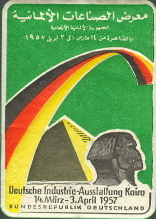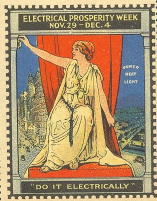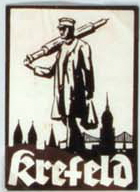Poster Stamps: Iconography
Deutsche Industrie-Ausstellung Kairo
(German Industry Exhibition, Cairo), 1957
By the 1950’s West Germany experienced a "wirtschaftswunder," or "economic miracle;" it had re-emerged from the devastation of World War II and become a global economic power. Germany’s 1957 industry exhibition was an opportunity to demonstrate its manufacturing and economic prowess. An industry trade fair in Egypt is interesting to think about vis-à-vis Germany’s delicate politics with the new state of Isreal. Furthermore, the Germans had had colonial ambitions in the region – through their alliance with Turkey — for the decades prior to the 1950’s.
The stamp’s "tourist/orientalist" iconography reduces Egypt to the ancient monuments, suggesting Egypt’s power, innovation and influence is a thing of the past. The colors of Germany's flag fill a rainbow (or a 1950s swooping, modernist arc) of industrial power and progress. The overall effect implies German progress and technology is leading — even dominating — Egypt.
Electrical Prosperity Week, n.d.
Like the posters they reproduced, the iconography of Poster Stamps could be subtle or straightforward. In this example the message is clear: an idealized woman reaches for a switch on one of the columns that frame her encouraging us to emulate her and "DO IT ELECTRICALLY."
Steamfitter
The iconography for Lewis Hine’s famous photo of a Steamfitter (1920) was not unique; the 1916 Newark N.J. stamp predated Hine, the 1924 Nykøbind Falster stamp came directly after. There is a difference in the meaning of the iconogoraphy however; the stamps around Hine’s photograph all glorify machinery in various ways. Hine's photo emphasizes that labor produces industrial wealth, not machines.
Krefeld, 1920's
At first glance this image is clear: a soldier shoulders his gun and marches before the skyline of Krefeld. But look closer at the gun’s odd shape; is it a gun? A bazooka? An oversized pen? Since Krefeld is a textile center the 'gun' must be a bolt of cloth, the 'soldier' a worker (note the lunch sack in his left hand). But the figure does mimic a soldier: the marching stance and the bolt positioned like a rifle.
What about 1920’s Krefeld could explain this?
In 1923 Germany suspended payment of reparations from the First World War. In response French and Belgian troops occupied the Ruhr region, the center of Germany's industrial production including the city of Krefeld. The occupation was met with passive resistance and guerrilla warfare. Perhaps this stamp subtly encouraged Germans to resist by depicting a worker who could be mistaken — or taken — for a soldier.
Thanks to James Van Dyke, Visiting Professor of Art History, for his help in interpreting this iconography.
| Home | Poster Stamps | Poster Stamp Design | Poster Stamp Iconography |



